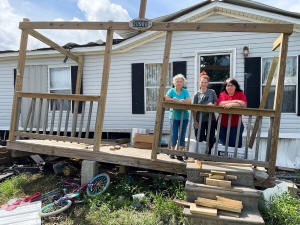A month after Ida's landfall, Louisianians decry 'Third World'
conditions
 Send a link to a friend
Send a link to a friend
 [October 05, 2021]
By Brad Brooks [October 05, 2021]
By Brad Brooks
CROZIER, La. (Reuters) - Bruce Westley
stood outside his wrecked mobile home, pointing to a small lime green
tent, two patio chairs and a 30-quart aluminum pot atop a single propane
burner.
"For more than a month, that's been our bedroom, our living room and our
kitchen," said the 65-year-old disabled Navy veteran. He and his wife
Christina are among thousands of southeast Louisianians struggling more
than a month after Hurricane Ida swept through the heart of Cajun
country.
Reuters traveled the bayous of hard-hit Terrebonne, Lafourche, Jefferson
and Plaquemines parishes in recent days, speaking with more than 40
residents. All said they felt abandoned by state and federal officials.
A few said they had not received any type of support from any level of
government.
"We can't keep living like this," Westley said. "We just need any damn
thing to get off the ground, man."
In most areas it looked as if Ida rolled through only a day or two ago.
Old timers who say they've seen it all swear they have never witnessed a
more destructive storm.

A Federal Emergency Management Agency (FEMA) spokesman said the agency
was working as quickly as possible. Louisiana's Governor John Bel
Edwards on Monday announced a temporary sheltering program supported by
FEMA that he said would start bringing trailers into the hardest-hit
areas to alleviate housing shortages.
The human misery and the piles of debris testify to the massive strain
on public and private resources in a hurricane-prone area. The scenes
also raise questions about how the United States will cope as climate
change creates a new, more destructive normal.
Reuters saw no heavy equipment, trucks or workers helping people clear
the rubble and recover their belongings. The only government presence
was in the form of law enforcement officers and staff at FEMA mobile
centers processing disaster claims. Residents said it has basically been
that way since Ida made landfall on Aug. 29 and killed 26 people.
Hundreds of people, many of them elderly and children, were in tents.
Others were in homes that clearly have severe structural damage and
where mold, which can impact respiratory health and cause severe
allergic reactions, was spreading.
Grocery stores, most restaurants and other businesses remain closed.
Power is still out for thousands of people and many have no water or
sewage services.
Despite the difficulties, communities are trying to band together.
Outside the Howard Third Zion Travelers Baptist Church just two blocks
down from where Westley and his wife are camping, volunteers say they
have been handing out meals to 1,000 families daily. Ida destroyed the
church's south-facing wall.
"You want to know what's been going on to help these people? Pretty much
nothing," said Talisa Clark, a community activist for the historically
Black area who has been helping coordinate the food distribution. "There
are no state or federal boots on the ground to help. It's looking like a
Third World country's efforts down here."

Clark was forced out of her badly damaged home near Houma and has been
staying with relatives.
Parish officials for Terrebonne, Lafourche, Jefferson and Plaquemines
did not respond to a request for comment.
DIFFICULT CHOICES
John Mills, a Federal Emergency Management Agency (FEMA) spokesman at a
support site in Galliano, Louisiana, said he understood the frustrations
of those who survived Ida.
"Families and communities will have to face difficult choices about how
to rebuild - and whether to rebuild here at all," he said.
[to top of second column]
|

Rosie Verdin, along with her daughters Gabrielle Rosenberger
(middle) and Nathanie Verdin, pose for a photo on the porch of
Rosie’s mobile home in Golden Meadow, Louisiana, on October 1, 2021.
REUTERS/Brad Brooks

FEMA is distributing money so people can rent housing
for at least two months. In addition, as of Monday FEMA said it was
paying hotel costs for nearly 8,000 families. In total, it estimates
it has spent at least $30 million in hotel costs.
"That plan probably works under most circumstances. But the breadth
of Ida's damage is so huge, that there's no housing stock, there's
no hotel rooms available," said Tanner Magee, a state representative
whose district includes Terrebonne parish.
State and parish governments have contracted out the task of picking
up debris, but have struggled with even deciding on where they will
put it, Magee said. He said far more workers and trucks were needed
in hard-hit areas.
Magee and his family, who live in Houma, are staying in his
Ida-damaged home.
"If you see this destruction around you constantly and it's not
going anywhere, it beats down on people," Magee said. "I'm really
worried about the mental health of people."
Magee and others say they need temporary FEMA trailers. FEMA says
that takes several weeks, and is complicated by federal and state
regulations that make it difficult to bring in temporary shelters
during hurricane season.
FEMA, along with the Small Business Administration, has paid out
over $1.1 billion for Ida damage so far, mostly through grants to
homeowners, along with FEMA's national flood insurance program.
Uninsured damage estimates are upward of $19 billion, according to
the property data and analytics company CoreLogic, with 90% of those
losses along Louisiana's coast, and the rest in Alabama and
Mississippi. There could be another $21 billion in damage to insured
properties.

STAY RIGHT HERE
In Galliano, Maria Molina handwashed shirts and shorts for her
7-year-old daughter Julia and grown son Leonardo; she then hung them
out to dry.
"I'm out of work, I'm out of money and we're out of food. We don't
have anywhere to go, even though this trailer seems unsafe," she
said of her blue mobile home, which was now akilter with a damaged
roof and foundation.
Molina was awaiting word on whether she'll qualify for any FEMA aid.
Down the road in the town of Golden Meadow, Rosie Verdin, 73, stood
on the tilted porch of her home behind the tribal headquarters of
her United Houma Nation.
Verdin said Ida's destruction was the worst she'd seen. Some
three-fourths of her tribe's 19,000 members saw their homes
destroyed or left uninhabitable.
"But there is nothing that will drive us off this land," she said.
"With or without help, we'll rebuild and stay right here."
(Reporting by Brad Brooks; Editing by Donna Bryson and Aurora Ellis)
[© 2021 Thomson Reuters. All rights
reserved.] Copyright 2021 Reuters. All rights reserved. This material may not be published,
broadcast, rewritten or redistributed.
Thompson Reuters is solely responsible for this content.
 |